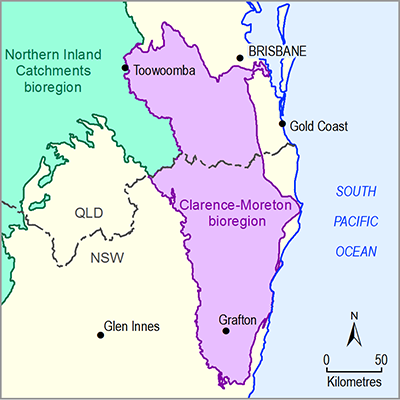- Home
- Assessments
- Bioregional Assessment Program
- Clarence-Moreton bioregion
- 2.6.1 Surface water numerical modelling for the Clarence-Moreton bioregion
- 2.6.1.3 Model development
- 2.6.1.3.3 Choice of seasonal scaling factors for climate trend
In order to generate a future climate trend for the BA, the objective is to choose the set of global climate model (GCM) seasonal scaling factors that give the median change in mean annual precipitation in the Clarence‑Moreton bioregion.
There are 15 available GCMs with the seasonal scaling factors for each of the four seasons: summer (December–February), autumn (March–May), winter (June–August) and spring (September–November). For each GCM the change in mean seasonal precipitation that is associated with a 1 °C global warming is calculated. These seasonal changes are then summed to give a change in mean annual precipitation.
The resulting changes in mean annual precipitation for a 1 °C global warming in the Clarence‑Moreton bioregion are shown in Table 3 for each GCM. The 15 GCMs predict changes in mean annual precipitation ranging from –6.9% (i.e. a reduction in mean annual precipitation) to 3.7% (i.e. an increase in mean annual precipitation). The GCM with the median change is CSIRO Mk3.0 (Gordon et al., 2002). The corresponding projected change in mean annual precipitation per degree of global warming is a reduction of 1.8%, or about 17.9 mm. The seasonal scaling factors for CSIRO Mk3.0 are +4.3% (summer), –5.7% (autumn), –2.5% (winter) and –7.5% (spring). In other words, projected increases in precipitation in the wettest season, summer, are offset by projected decreases in the other three seasons.
Table 3 List of 15 global climate models (GCMs) and their predicted change in mean annual precipitation across the Clarence‑Moreton bioregion per degree of global warming
Data: CSIRO (Dataset 1)
The seasonal scaling factors associated with CSIRO Mk3.0 are used to generate trended climate inputs for the years 2013 to 2102. The trends assume global warming of 1 °C for the period 2013 to 2042 (compared to 1983 to 2012). The global warming for 2043 to 2072 is assumed to be 1.5 °C and the corresponding scaling factors for this period are therefore multiplied by 1.5 (compared to 1983 to 2012). The global warming for 2073 to 2102 is assumed to be 2 °C (compared to 1983 to 2012).
Future climate input series are produced based on scaling the 1983 to 2012 (30 years) climate input series. The data for this period is repeated a further three times but with increasingly trended climate change scalars (2013 to 2042, 2043 to 2072, 2073 to 2102). The resulting annual precipitation time series for the Richmond river basin is shown in Figure 6. It can be seen from Figure 6 that the decrease in precipitation from 2013 to 2102 is substantially less than the typical inter-annual variability.

Product Finalisation date
- 2.6.1.1 Methods
- 2.6.1.2 Review of existing models
- 2.6.1.3 Model development
- 2.6.1.4 Calibration
- 2.6.1.5 Uncertainty
- 2.6.1.6 Prediction
- 2.6.1.6.1 Annual flow (AF)
- 2.6.1.6.2 Interquartile range (IQR)
- 2.6.1.6.3 Daily streamflow at the 99th percentile (P99)
- 2.6.1.6.4 Flood (high-flow) days (FD)
- 2.6.1.6.5 Daily streamflow at the 1st percentile (P01)
- 2.6.1.6.6 Low-flow days (LFD)
- 2.6.1.6.7 Low-flow spells (LFS)
- 2.6.1.6.8 Longest low-flow spell (LLFS)
- 2.6.1.6.9 Zero-flow days (ZFD)
- 2.6.1.6.10 Summary and conclusions
- References
- Datasets
- Citation
- Contributors to the Technical Programme
- Acknowledgements
- About this technical product

